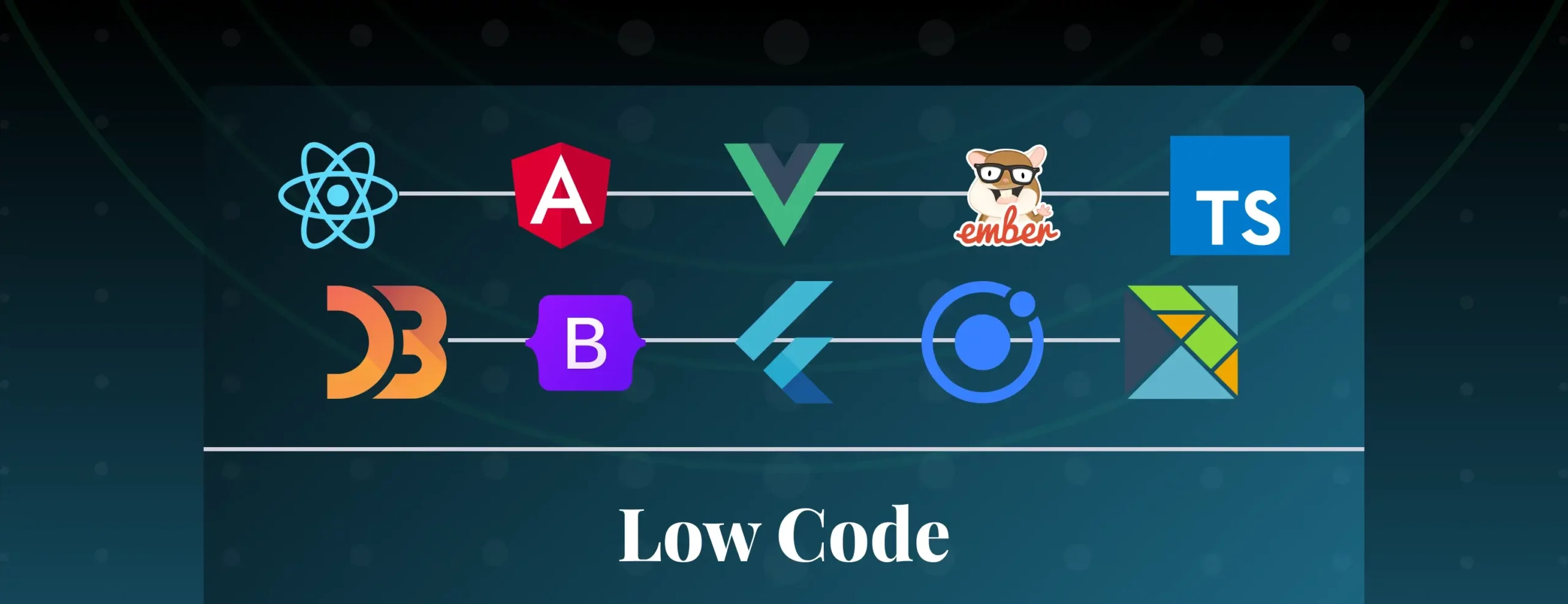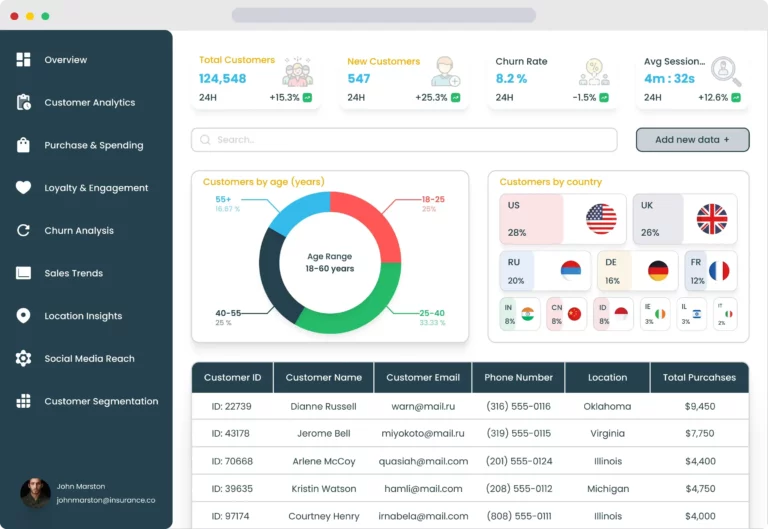

How frontend technologies are getting replaced with low code?
Replacing frontend technologies with low-code
A few years ago, creating an internal tool would mean going through several planning rounds, prolonged development time, and endless feedback loops, choosing the right frontend technologies, libraries, and frameworks for your requirements. In addition, recruiting highly skilled programmers, security consultants, and cloud experts would be necessary, resulting in high development costs.
Apart from all the things mentioned, frontend technologies involve a high learning curve and keep on changing frequently. Once you have learned a framework, you will always find fresh updates that the users may find difficult to keep up with. This can severely impact the flow of the developer’s journey.
Thanks to low-code technology, things are changing for the better. Now developers and business users can design the same application with less than half of the effort, time, and resources to address urgent and unique business needs. Low code empowers users to create powerful applications that are flexible, agile, and easily scalable. While it enables subject matter experts and business users to concretize their visions, it simultaneously simplifies IT experts’ jobs and promotes cross-team collaboration.
The global low-code development market is estimated to generate a revenue of $187.0 billion by 2030, and is predicted to grow at a pace of 31.1% CAGR during the forecast period (2020-2030). This article will focus on how and why low-code is taking over popular frontend technologies that you can stop using.
Why low-code for frontend development?
66% believe the main motive of low-code development platforms is digital transformation and increased responsiveness and 45% use the platform to reduce dependencies on IT professionals. Business applications need to be intuitive and easy to use, but they also need to be effective and responsive to ever-evolving market trends and business needs.

Low-code platforms are conventional platforms that focus on the two most important aspects – design and development of frontend and adding business logic easily while offering flexibility for incorporating changes that are market-ready. Additionally, it helps minimize the back-end efforts and enhances the user experience while allowing more customization options.
Here is why a lot of businesses are turning to low-code platforms like DronaHQ and ditching front-end technologies-
Rapid application delivery
With the ever-evolving and competitive market landscape, businesses need to innovate unique solutions rapidly, which is impossible when opting for custom app development. Low-code platforms’ USP lies in their capability to accelerate software delivery for unique cases.
Creating a custom app takes a lot of time and manual effort. From research, conceptualization, and designing to several rounds of feedback, it is not an appropriate choice when fulfilling urgent market demands. Super fast delivery and flexibility to respond to unique needs and market trends make low-code a suitable choice over other frontend technologies.
Combating IT bandwidth issues
The in-house IT team across businesses is generally preoccupied with everyday crucial business tasks and customer-facing tools and operations, leaving them minimal time to focus on enterprise applications. Thanks to low-code solutions, internal business users and subject matter experts are enabled to design and create applications.
This also leaves the IT team more time to focus on core business activities, as they don’t have to build applications from scratch, but use the building blocks, ready UI elements, ready connectors, and business logic components. IT leaders and business users can work collaboratively without investing much time in building high-functioning applications.
Graphical visual modeling
Low-code allows graphical configuration from a library of ready components and connectors, unlike frontend technologies that use advanced-level computer programming to create new applications or update existing ones. The built-in components of a low-code platform can present any information in a comprehensible format to users, irrespective of their level of technical expertise, making it a super convenient solution for business users.
Rapid iterations
41% of enterprises were already on low-code platforms, and 10% were planning to get it soon in 2019. One of the vital reasons for its massive popularity is its ability to cope with changes easily. Low-code solutions are dynamic and have the capability to rapidly iterate on requests rather than writing a thousand lines of code for every simple application update. While other frontend technologies may take up to months of planning and coding for a single update, low-code applications can be updated and modified with a few clicks and be market ready in minutes. Also, you need a dedicated team of developers to maintain and update the code in frontend technologies, which is not a concern in low code.
Integrated data sources
All the top low-code platforms offer connectivity to databases and multiple third-party applications, promoting productivity and saving time. For example, in DronaHQ, rapid connectivity with databases, APIs and other productivity tools like MySQL, Slack, Gmail, Github, etc, makes the low-code platforms a desirable replacement for frontend technologies.
Frontend technologies that can be replaced with low-code/No code
Forrester estimates that the low-code market will top $21 billion in spending by 2022. With low-code domination, many front-end technologies are already losing their charm for business users. Here are some popular frontend technologies that can be replaced with low-code/no-code –
Angular
Angular is a popular frontend development framework introduced by Google in 2009 aimed at building dynamic web applications. Angular is written in typescript (type-safe and JavaScript) whose core the users can import libraries and functionalities into their applications. Its key components include pre-built templates, MVC architecture, code generation, splitting, and more.
Why not Angular?
1. Heavily weighted framework.
2. Limited SEO options and poor accessibility for search engine crawlers.
3. High learning curve.
4. Performance tradeoff.
React
React is one of the most popular front-end JavaScript libraries, used by more than 70% of developers. It is used by some of the biggest tech websites like GitHub, Stack Overflow, etc. This open-source frontend library is maintained and supported by Facebook, released in 2013. The library is designed to help web developers create fast single-page applications and user interfaces.
Why not React?
1. Lack of proper documentation to guide developers.
2. A constantly evolving library results in constantly relearning new processes or mechanics.
3. Confusing JSX syntax.
Vue.js
Vue.js is a JavaScript framework released in 2014 for creating web app interfaces and single-page applications. It is an open-source platform utilizing the model-view-viewmodel (MVVM) architectural model that allows for the business logic, pr model to be distinguished from the graphical UI, or view, work for creating web interfaces. Vue.js combines the strongest parts of React and Angular.
Why not Vue.js?
1. Tends to be over-flexible.
2. Limited components and plugins.
3. Language barrier: A lot of the documentation is in the developer’s native language.
Elm
Elm is an open-source domain-specific language for reactive web frontend development. It is purely functional, focusing on usability, performance, and robustness. It first appeared in 2012 for creating web browser-based graphical user interfaces with decoupled and easy-to-rewrite code and immutable variables.
Why not Elm?
1. Lack of proper documentation and detailed manuals.
2. Complex format.
3. Difficulty in records handling.
Ionic
Ionic is a promising front-end development and cross-platform mobile application development technology, allowing developers to create a production-ready app much faster than traditional development. You need to be familiar with Angular to start developing and have prior knowledge of SCSS to design your application visually.
Why not Ionic
1. Unstable native plugins.
2. Debugging can be challenging because of unclear error messages.
3. Limited default features.
Flutter
Flutter is Google’s open-source technology built-in 2017 on Dart, where developers can create mobile, desktop, and web apps with a single codebase. Unlike its competitors, Flutter is not a framework or library but a complete Software Development Kit (SDK). It includes a rendering engine, ready-made widgets, testing and integration APIs, etc.
Why not Flutter?
1. Not enough libraries and limited support for native development.
2. Unpredictable development.
3. Large app size.
Bootstrap
Bootstrap is one of the most popular front-end web development frameworks, released in 2011 by Mark Otto. It is based on HTML5, CSS, and JavaScript, making it possible for developers to launch a fully-featured, mobile responsive site quickly. Developers must learn the bootstrap framework to fully understand and utilize the customization capabilities.
Why not Bootstrap?
1. High and time-consuming learning curve.
2. No easy customization options.
3. Heavy generated files.
Typescript
Typescript is an open-source programming language developed by Microsoft that compiles JavaScript and was released in 2012. The language continues to gain popularity every year and remains in active development. TypeScript applications are scalable, responsive, bug-free, and easy to maintain.
Why not Typescript?
1. Highly complicated typing system.
2. Absence of strong security features.
3. Requires complication.
Ember.js
Ember.js is an open-source JavaScript single-page application framework released in 2011 that utilizes a component-service pattern. It uses an MVVM architecture and allows developers to create scalable web applications by incorporating common idioms, best practices, and other single-page-app ecosystem patterns into the framework.
Why not Ember.js?
1. Difficult to learn.
2. Heavy framework.
3. Limited component reuse functionality.
D3.js
D3.js is an interactive JavaScript library for producing dynamic data visualizations in web browsers. It was released in 2011 and uses scalable vector graphics, HTML5, and Cascading Style Sheets, supporting the processing of large data collections. D3.js allows developers to reuse code and manipulate document object models in programming.
Why not D3.js?
1. Steep and time-consuming learning curve.
2. Limited data sources.
3. Difficult to build visual design graphs.
Choose DronaHQ for frontend development
DronaHQ is the perfect low-code replacement for the above frontend technologies. Build high-functioning applications with 100+ responsive, reusable, and out-of-the-box components so you don’t need to build the frontend from scratch. It is easy to customize with JavaScript in the platform and you can also create custom UI components using a drag-and-drop UI control designer. Autogenerate critical app screens like Forms and CRUD operation. Get responsive applications on both web and mobile and across devices (iOS + Android).
In addition to offering ease of application development, DronaHQ offers enterprise-ready solutions such as SSO, user permissions and access control in a fully secure environment protected with ISO 27001 and SOC-II certifications. Integrate with any API and visualize multiple data sources in the same view. Sign up now and get 24×7 customer support, tutorials, and documentation to get started!